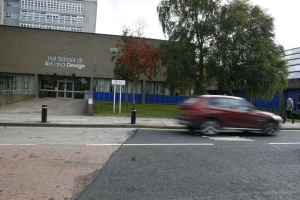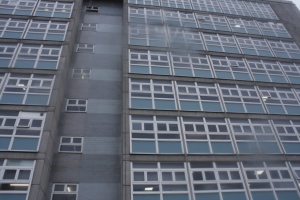After the introductions where out of the way, we then started the actual Photography sessions in which I could expand my knowledge and learn new things, that I already didn’t know about. Within the first session, as a group we discussed the different compositional elements associated and seen within photography. If instance things such as; The Rule of Thirds, leading lines, depth of field, framing, balancing elements, symmetry and pattern, golden triangle and backgrounds.
To illustrate what has been said, I have decided to log and reflect on the different sessions. This will allow me to comprehensively showcase my knowledge and understanding of the days’ session. I will also use elucidated examples of primary work and from secondary sources to help back up what I am talking about and to help give a visual aid.
Since, this was the groups first session in photography, there was no practical side to the session, we just went through the basic technical camera techniques used when taking an image. When entering any field, it is extremely important to have an understanding of the basics as this gives you a ‘foot in the door’. Even though, this was going back to revisit what I had already learned whilst studying on my previous course, it was a helpful and useful refresher and helped to jog my memory. I truly believe this will help me come a much better practitioner of my own work.
The first photography technique I am going to discuss is depth of field. Depth of field does exactly what it states, it adds depth to an image. Depth of field is measured from in front of the focal point in the image and going behind the focus point. To show my own understanding I attempted to take my own photograph using this technique.

Photo source: Taken by me
The shutter speed was 1/50 of a second which allowed with the light conditions, a larger aperture of F.5 allowing the background to appear out of focus.
Above is my example of depth of field, which basically my nephew who is the main focal point in the image because he is the first thing which the viewer is drawn to because the background is blurred out. The boy is fairly sharp in the image in comparison to the background. He is considered, the more important subject in comparison to the background, in objective terms. I believe this image works really well as it shows the depth in the image and helps to isolate the boy making him the focal point and therefore the most important subject in the image.
There are different types of depth of field but basically it is what is in focus in an image. Shallow and Deep are the two different terms that are commonly associated when describing the qualities of the depth of field. The shallow depth of field means that only a small proportion of the photo will be in focus. A deep depth of field is when the majority or all of the image is in focus. This means that very little or no blurring occurs. Three factors play an essential part to a professional looking image. These are; the aperture size, shutter speed and good exposure gained by the aperture and shutter speed being correct.
The next element I will be talking about is symmetry and pattern, this is fairly simple really. Symmetry is where if an image was to be folded in half than it would replicate or be very similar to the other side. Symmetry is all around us in day to day life’s. From buildings with lots of windows, to fences or even brick work. I have taken a image to show my understanding visually. the image below shows an example of symmetry as if there was a mirror placed down the centre of the image it would reflect the same or similar image to what is already there. the only difference would be that the numbers wouldn’t show a reflection of itself. this works really well as the human eye is generally satisfied with things that follow a structure.

Photo source: Taken by me
Another compositional element that is crucial is the framing. Framing is not just about placing the subject smack bang in the middle of the frame, it is about making it look aesthetically appealing so that the viewer will be stay focus on the image and not to make them visually annoyed or challenged. Framing is so important as it can change to full tone and mood of an image. If the framing is not right then it will not have the right affects on the audience, which can change the ways they take the information given out by the image. The image below shows a good example of how good framing makes an image work really well. For instance, the images has a sense of depth and layers. This could have easily have been manipulated in Photoshop, by merging to images together. Also the framing helps to leading the eye towards your main focal point which in this case I believe to be the tops of the trees and the sea.
My favourite compositional technique is leading lines. leading lines are line that direct the viewers eye into the image. it generally highlights a specific part in the image making it the focal point, the lines do not necessarily have to be straight. they can curve or bend. Lines can create depth to a photo as the lines can appear to get smaller the further away they get in the image. To show my understanding i have found an image online to demonstrate what i mean
In this image there is a leading line that draws the viewers attention into the image. This helps give the viewer visual direction (unconsciously) making them scan the picture from the bottom to top. The tone is set instantly by the image been in black and white. It gives a sense on eeriness and a dark side. In the top left corner of the image the sun light shines through making the image blurry at that side this means that if the image was in colour the preferred meaning behind it might be lost. Because the image is in black and white the viewers can see the full image without been drawn to a particular point. The way the image has been taken is as if the photographer was standing on the track. The image is taken at the viewpoint at low angle so is very close to the track lines the helps to emphasis the sense of how long the track is and makes the image seem like its going on forever. The track seems like its getting narrower and narrower as the track gets a further away distance, however individuals are aware that it stays the same width all the way down. Because of the tone been quite dark and eerie, this also helps that the photographer took the image in the middle of the track. This increase the levels of moral panic.The lighting in this photo would of been natural lighting as a photographer doesn’t use both artificial and natural in one shot. Lighting in this photograph helps to enhance the image and helps to soften the tone of the image making it seem really natural and not forced.There is no negative space so gives more focus and emphasis on the positive space in the image. Repetition is seen within this image as the tracks follows the mechanical structure allowing it to work.
The rule of thirds is another photographic technique that a lot of photographers use in there work. The idea behind the rule of thirds is that if you divide the image into 9 equal sections, then if you place the points of interesting along the lines or on the intersections the photo becomes more significant and balanced. This means that it gives the image structure and can also alongside with other techniques give the image depth. There is an image that i really like that uses the rule of thirds. this was one of Sebastião Salgato’s pieces which we looked at in class. it has the main subjects mainly in one third of the image.
The last compositional technique is the golden triangle, this is the one I’m least familiar with, however my understanding of it is that hyperthetically if you was to drawn on three diagonal triangles of all different sizes. that the main focal points would fall into one of the triangles. there should be 1 large triangle that comes in from one corner of the image through the centre of the image and the two smaller triangles. to show my understanding more this image shows visually what i mean.

















